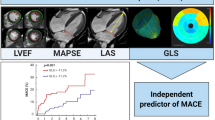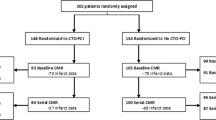Abstract
Late infarct size (IS) after ST segment elevation myocardial infarction (STEMI) is a determinant of subsequent mortality. Late Gadolinium enhancement in cardiac magnetic resonance imaging (LGE-CMRI) is the gold standard for IS measurement, however, it is not readily accessible in many areas. We aimed to evaluate the value of early baseline 2D-echocardiographic global longitudinal strain (GLS) for the prediction of late IS after STEMI. From October 2017 to July 2018, we studied 100 patients with their 1st anterior STEMI treated with primary percutaneous coronary intervention. Baseline GLS calculation was performed within 48 h of admission. In addition, the average value of the nine segments supplied by the LAD was assessed separately (anterior GLS). Infarct size was assessed 3 months later using LGE-CMRI, and large infarcts were defined as ≥ 20% LV myocardium covered by scar. Based on CMRI, we defined two groups; 57 patients with large infarcts (group I) and 43 patients with small infarcts (group II). Both groups were matched in all baseline demographics and risk factors. There was a good and significant correlation between GLS and late IS (r = − 0.840, P < 0.001). This correlation was even higher for anterior GLS (r = − 0.867, P < 0.001). ROC analysis showed a cut-off point of GLS (− 13%) that identified large late IS with a sensitivity and specificity of 66.7% and 88.4% respectively (AUC = 0.85). For anterior GLS, the cut-off point was − 9.6% (Sensitivity 94%, specificity 86%, AUC = 0.9). We concluded that baseline GLS significantly predicts late IS after anterior STEMI.



Similar content being viewed by others
References
Carrabba N, Valenti R, Parodi G, Santoro G, Antoniucci D (2004) Left ventricular remodeling and heart failure in diabetic patients treated with primary angioplasty for acute myocardial infarction. Circulation 110:1974–1979
Vink M, Dirksen M, Suttorp M, Tijssen J, van Etten J, Patterson M et al (2011) 5-year follow-up after primary percutaneous coronary intervention with a paclitaxel-eluting stent versus a bare-metal stent in acute ST-segment elevation myocardial infarction: a follow-up study of the PASSION (Paclitaxel-Eluting Versus Conventional Stent in Myocardial Infarction with ST-Segment Elevation) trial. JACC 4:24–29
Kancharla K, Weissman G, Elagha A, Kancherla K, Samineni S, Hill P et al (2016) Scar quantification by cardiovascular magnetic resonance as an independent predictor of long-term survival in patients with ischemic heart failure treated by coronary artery bypass graft surgery. J Cardiovasc Magn Reson 18:45
Piechnik S, Ferreira V, Dall’Armellina E, Cochlin L, Greiser A, Neubauer S et al (2010) Shortened modified look-locker inversion recovery (ShMOLLI) for clinical myocardial T1-mapping at 1.5 and 3 T within a 9 heartbeat breathhold. J Cardiovasc Magn Reson 12:69
Diao K, Yang Z, Ma M, He Y, Zhao Q, Liu X et al (2017) The diagnostic value of global longitudinal strain (GLS) on myocardial infarction size by echocardiography: a systematic review and meta-analysis. Sci Rep 7:10082
Sjøli B, Ørn S, Grenne B, Vartdal T, Smiseth O, Edvardsen T et al (2009) Comparison of left ventricular ejection fraction and left ventricular global strain as determinants of infarct size in patients with acute myocardial infarction. J Am Soc Echocardiogr 22:1232–1238
Sjøli B, Ørn S, Grenne B, Ihlen H, Edvardsen T et al (2009) Diagnostic capability and reproducibility of strain by Doppler and by speckle tracking in patients with acute myocardial infarction. JACC 2:24–33
Grabka M, Wita K, Tabor Z, Paraniak-Gieszczyk B, Chmurawa J, Elzbieciak M et al (2013) Prediction of infarct size by speckle tracking echocardiography in patients with anterior myocardial infarction. Coron Artery Dis 24:127–134
Lønborg J, Vejlstrup N, Kelbæk H, Holmvang L, Jørgensen E, Helqvist S et al (2012) Final infarct size measured by cardiovascular magnetic resonance in patients with ST elevation myocardial infarction predicts long-term clinical outcome: an observational study. Eur Heart J Cardiovasc Imaging 14:387–395
Lang R, Bierig M, Devereux R, Flachskampf F, Foster E, Pellikka P et al (2005) American Society of Echocardiography’s Guidelines and Standards Committee; European Association of Echocardiography. Recommendations for chamber quantification: a report from the American Society of Echocardiography’s Guidelines and Standards Committee and the Chamber Quantification Writing Group, developed in conjunction with the European Association of Echocardiography, a branch of the European Society of Cardiology. J Am Soc Echocardiogr 18:1440–1463
Ersbøll M, Valeur N, Mogensen U, Andersen M, Møller J, Velazquez E et al (2013) Prediction of all-cause mortality and heart failure admissions from global left ventricular longitudinal strain in patients with acute myocardial infarction and preserved left ventricular ejection fraction. J Am Coll Cardiol 61:2365–2373
McAlindon E, Bucciarelli-Ducci C, Suleiman M, Baumbach A (2014) Infarct size reduction in acute myocardial infarction. Heart 101(2):155–160
Bulluck H, Hammond-Haley M, Weinmann S, Martinez-Macias R, Hausenloy DJ (2017) Myocardial infarct size by CMR in clinical cardioprotection studies: insights from randomized controlled trials. JACC 10:230–240
Gjesdal O, Helle-Valle T, Hopp E, Lunde K, Vartdal T, Aakhus S et al (2008) Noninvasive separation of large, medium, and small myocardial infarcts in survivors of reperfused ST-elevation myocardial infarction clinical perspective: a comprehensive tissue Doppler and speckle-tracking echocardiography study. Circ Cardiovasc Imaging 1:189–196
Gjesdal O, Hopp E, Vartdal T, Lunde K, Helle-Valle T, Aakhus S et al (2007) Global longitudinal strain measured by two-dimensional speckle tracking echocardiography is closely related to myocardial infarct size in chronic ischaemic heart disease. Clin Sci 113:287–296
Bière L, Donal E, Terrien G, Kervio G, Willoteaux S, Furber A et al (2014). Longitudinal strain is a marker of microvascular obstruction and infarct size in patients with acute ST-segment elevation myocardial infarction. PLoS ONE 9(1):e86959
Zhu W, Liu W, Tong Y, Xiao J (2014) Three-dimensional speckle tracking echocardiography for the evaluation of the infarct size and segmental transmural involvement in patients with acute myocardial infarction. Echocardiography 31:58–66
Aly M, Kleijn S, Menken-Negroiu R, Robbers L, Beek A, Kamp O (2016) Three-dimensional speckle tracking echocardiography and cardiac magnetic resonance for left ventricular chamber quantification and identification of myocardial transmural scar. Neth Heart J 24:600–608
Acknowledgements
We appreciate the invaluable insights of Dr. Mohamed Bendary for statistical data analysis. We also greatly acknowledge Dr. Tarek Afifi for his efforts in preparation of CMRI procedures.
Author information
Authors and Affiliations
Corresponding author
Ethics declarations
Conflict of interest
The authors declare that they have no competing interests.
Rights and permissions
About this article
Cite this article
Bendary, A., Afifi, M., Tawfik, W. et al. The predictive value of global longitudinal strain on late infarct size in patients with anterior ST-segment elevation myocardial infarction treated with a primary percutaneous coronary intervention. Int J Cardiovasc Imaging 35, 339–346 (2019). https://doi.org/10.1007/s10554-018-1498-7
Received:
Accepted:
Published:
Issue Date:
DOI: https://doi.org/10.1007/s10554-018-1498-7




